

Elementary mathematics. An illustration using apples to show that 2+3 and 3+2 are both equal to 5.
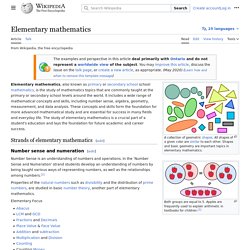
Apples are frequently used to explain arithmetic in textbooks for children.[1] Elementary mathematics consists of mathematics topics frequently taught at the primary or secondary school levels. The most basic topics in elementary mathematics are arithmetic and geometry. Beginning in the last decades of the 20th century, there has been an increased emphasis on problem solving. Elementary mathematics is used in everyday life in such activities as making change, cooking, buying and selling stock, and gambling. In secondary school, the main topics in elementary mathematics are algebra and trigonometry. Topics[edit] According to a survey of the math curriculum of countries participating in the TIMSS exam, the following topics were considered important to the elementary curriculum (years 1-8) by at least two-thirds of the highest-performing countries:[4] Whole numbers[edit] Main article: Whole number Measurement units[edit]
Different kinds of math use different parts of brain, research finds. A study by researchers from France and MIT published in the May 6 issue of Science indicates that learning the multiplication table may be more akin to memorizing a laundry list than exercising mathematical skills.
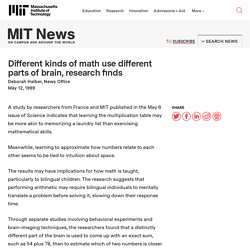
Meanwhile, learning to approximate how numbers relate to each other seems to be tied to intuition about space. The results may have implications for how math is taught, particularly to bilingual children. The research suggests that performing arithmetic may require bilingual individuals to mentally translate a problem before solving it, slowing down their response time. Through separate studies involving behavioral experiments and brain-imaging techniques, the researchers found that a distinctly different part of the brain is used to come up with an exact sum, such as 54 plus 78, than to estimate which of two numbers is closer to the right answer. Developing the latter skill may be more important for budding mathematicians. The brain-imaging evidence collected by Dr. Discalculia.pdf. Elementary Number Theory Mind Map.
Numeracy skills in patients with degenerative disorders and focal brain lesions: a neuropsychological investigation. Scientists Put A 'Sixth Sense' For Numbers On Brain Map. One of the most famous scenes in the movie Rain Man unfolds when a waitress drops a box of toothpicks on the floor.
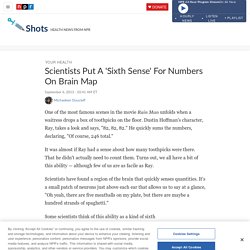
Dustin Hoffman's character, Ray, takes a look and says, "82, 82, 82. " He quickly sums the numbers, declaring, "Of course, 246 total. " It was almost if Ray had a sense about how many toothpicks were there. That he didn't actually need to count them. Turns out, we all have a bit of this ability — although few of us are as facile as Ray. Scientists have found a region of the brain that quickly senses quantities. In seconds, Ray knows there are 246 toothpicks dropped on the floor. Developmental dyscalculia. Dyslexic brain may solve some math problems in a roundabout way. The brains of children with dyslexia rely on unusual strategies to solve certain kinds of math problems, researchers report in the Nov. 1 NeuroImage.
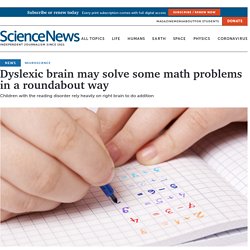
The findings could explain why dyslexia, a disorder of reading, can bring math troubles too. By revealing how the dyslexic brain tackles math, the research might eventually lead to better teaching methods, says study coauthor Guinevere Eden of Georgetown University Medical Center in Washington, D.C. Usually, people use regions on the right side of the brain to solve math problems that require a step-by-step process, such as subtraction and division; regions on the left side of the brain typically handle more rote, fact-retrieval problems such as addition and multiplication. Brain study reveals how successful students overcome math anxiety. Using brain-imaging technology for the first time with people experiencing mathematics anxiety, University of Chicago scientists have gained new insights into how some students are able to overcome their fears and succeed in math.

For the highly math anxious, researchers found a strong link between math success and activity in a network of brain areas in the frontal and parietal lobes involved in controlling attention and regulating negative emotional reactions. This response kicked in at the very mention of having to solve a mathematics problem. Teachers as well as students can use the information to improve performance in mathematics, said Sian Beilock, associate professor in psychology at the University of Chicago. Beilock and PhD student Ian Lyons report their findings in the article, “Mathematics Anxiety: Separating the Math from the Anxiety,” published Oct. 20 in the journal Cerebral Cortex.
The do's and dont's of teaching problem solving in math. Discalculia.pdf. 25.pdf. Working memory and mathematics_A review of developmental individual difference and cognitive approaches.pdf. Six Facts About Math LD. What Is Dyscalculia? RCML First Wilson Address.pdf. Testing for Learning Disabilities. There is no single “test” or even universally accepted approach to identifying learning disabilities (LD).

The characteristics of LD often differ from one child to another, and what LD looks like in children will sometimes manifest in very different ways in adolescents and adults. Features of LD can be “hidden” in some situations and very much apparent in others. The key to identifying LD is therefore to identify areas of strength and weakness, rule in (or rule out) any complicating factors that might be contributing to learning problems, and hone in on the very specific nature of the struggle, so that timely decisions can be made about carefully targeted intervention and support. Math Learning Disabilities. By: Kate Garnett While children with disorders in mathematics are specifically included under the definition of Learning Disabilities, seldom do math learning difficulties cause children to be referred for evaluation.
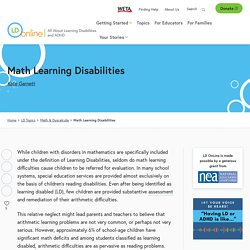
In many school systems, special education services are provided almost exclusively on the basis of children's reading disabilities. A Compendium of Neuropsychological Tests: Administration, Norms, and Commentary - Esther Strauss, Elisabeth M. S. Sherman, Otfried Spreen. Microsoft Word - Test reference guide.doc - test reference guide.pdf. The Neuropsychology of Math Disorders: - feiffer-mathematics.pdf.